Divine Comedy + Decameron discussion

This topic is about
The Divine Comedy
Dante's Commedia
>
14-20 April: Paradiso I-VII
date newest »
newest »
 newest »
newest »
We are going to see Reem relish in Paradiso (and not just for the cake).
In The Complete Danteworlds: A Reader's Guide to the Divine Comedy, it discusses the importance of the Islamic tradition in previous depictions of travels through Paradise and singles out the Libro della Scalla (Book of the Ladder) or mi'raj...
Reem will illustrate us more on this...!!!
In The Complete Danteworlds: A Reader's Guide to the Divine Comedy, it discusses the importance of the Islamic tradition in previous depictions of travels through Paradise and singles out the Libro della Scalla (Book of the Ladder) or mi'raj...
Reem will illustrate us more on this...!!!
Kalliope wrote: "We are going to see Reem relish in Paradiso (and not just for the cake).
In The Complete Danteworlds: A Reader's Guide to the Divine Comedy, it discusses the importance of the Islam..."
LOL Kalliope! Reem doesn't have this book, but Reem will do her best to google her way through Paradiso! I look forward to it!Doesn't that cake look good? mmmmm
In The Complete Danteworlds: A Reader's Guide to the Divine Comedy, it discusses the importance of the Islam..."
LOL Kalliope! Reem doesn't have this book, but Reem will do her best to google her way through Paradiso! I look forward to it!Doesn't that cake look good? mmmmm
 ReemK10 (Paper Pills) wrote: "WELCOME TO PARADISE
ReemK10 (Paper Pills) wrote: "WELCOME TO PARADISETorta Paradiso"
Yum! I like your idea of Paradise. :) But somehow I doubt it will sway Dante... who let's face it was probably spoiled with Tiramusu and Gelato and... *growly stomach*
 Kalliope wrote: "We are going to see Reem relish in Paradiso (and not just for the cake).
Kalliope wrote: "We are going to see Reem relish in Paradiso (and not just for the cake).In The Complete Danteworlds: A Reader's Guide to the Divine Comedy, it discusses the importance of the Islam..."
I have the Cambridge Companion but not the Complete Danteworlds... *sniffs*
Maybe the beautiful & generous & glorious Kalliope will enlighten us as we read? *puppy eyes*
 Canto I illustrations
Canto I illustrations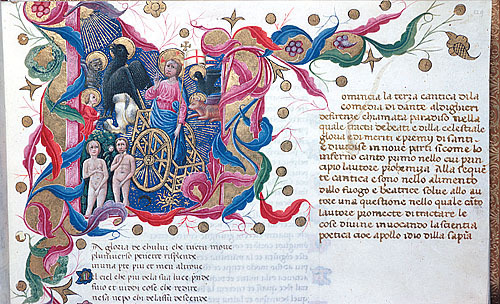
http://molcat1.bl.uk/IllImages/Kslide...
Christ in a chariot with Evangelist symbols, and Adam and Eve.
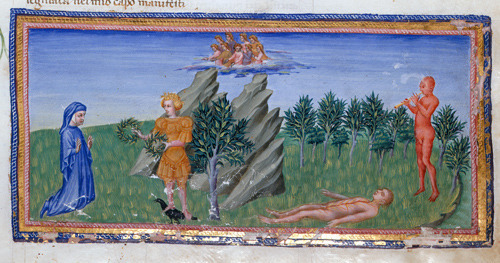
http://molcat1.bl.uk/IllImages/BLCD%5...
Dante and Apollo before Parnassus
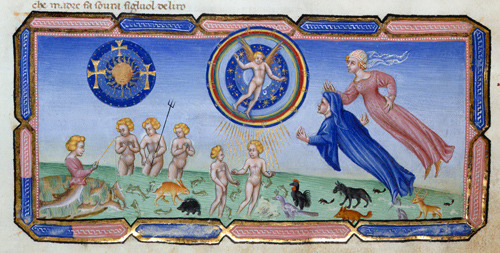
http://www.bl.uk/catalogues/illuminat...
Beatrice explaining to Dante that the universe is a hierarchy of being, with creatures devoid of reason in the early 'sea of being', and heaven as nine spheres rules by the figure of love.
More (view spoiler)
Book Portrait wrote: "Kalliope wrote: "We are going to see Reem relish in Paradiso (and not just for the cake).
In The Complete Danteworlds: A Reader's Guide to the Divine Comedy, it discusses the import..."
HaHa.. I know those "puppy" eyes...
In The Complete Danteworlds: A Reader's Guide to the Divine Comedy, it discusses the import..."
HaHa.. I know those "puppy" eyes...
BP, I think you posted somewhere a link to the entire Dali illustrations, but I can't find it..
Do you mind posting it again?
Thanks.
Do you mind posting it again?
Thanks.
 Kalliope wrote: "BP, I think you posted somewhere a link to the entire Dali illustrations, but I can't find it..
Kalliope wrote: "BP, I think you posted somewhere a link to the entire Dali illustrations, but I can't find it..Do you mind posting it again?
Thanks."
http://www.lockportstreetgallery.com/...
Voila madame. :)
{I'll check to make sure it's in the illustrations thread too... ETA: Lily posted the Dali links, msg 5 in the "Art in and inspired by the Commedia" thread}
 Kalliope wrote: "Google in Spain has this Doodle today, in celebration of Averroes' 888th Birthday.."
Kalliope wrote: "Google in Spain has this Doodle today, in celebration of Averroes' 888th Birthday.."Beautiful. Love it!
Kalliope wrote: "Google in Spain has this Doodle today, in celebration of Averroes' 888th Birthday..
"
You're on a roll discovering things today!!
"
You're on a roll discovering things today!!
 I find the opening canto denser and tougher going than any other before (I'm glad to be reading an annotated version) but also more exciting: Hell was a well-chartered territory, Purgatory felt like a watered-down version or maybe a half & half hybridation (half Hell, half Paradise) but Paradise is, at least for me, unchartered territory. And mind-tingling to visit. :)
I find the opening canto denser and tougher going than any other before (I'm glad to be reading an annotated version) but also more exciting: Hell was a well-chartered territory, Purgatory felt like a watered-down version or maybe a half & half hybridation (half Hell, half Paradise) but Paradise is, at least for me, unchartered territory. And mind-tingling to visit. :)
 Not for the faint of heart: Marsyas and Apollo
Not for the faint of heart: Marsyas and Apollohttp://en.wikipedia.org/wiki/Marsyas#...
For the subject see Ovid, 'Metamorphoses' (6). Apollo defeated the satyr Marsyas in a musical competition; as a punishment for failure, Apollo flayed him.
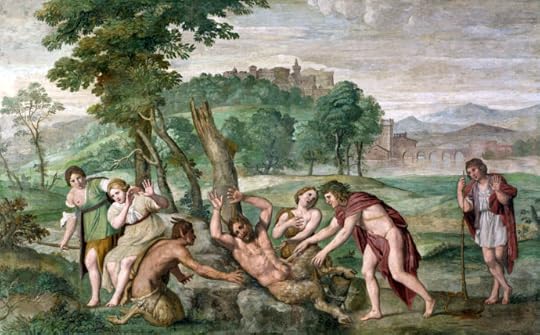
Domenichino and assistants - The Flaying of Marsyas (1616)
http://www.nationalgallery.org.uk/pai...
More (gruesome!) (view spoiler)
 I.58-60. When Dante looks up into the sun I pictured solar flares:
I.58-60. When Dante looks up into the sun I pictured solar flares:
Io nol soffersi molto, né sì poco,
ch'io nol vedessi sfavillar dintorno,
com' ferro che bogliente esce del foco;
I did not bear it long, but not so briefly
as not to see it sparkling round about,
like molten iron emerging from the fire;
More (so beautiful) (view spoiler)
 Book Portrait wrote: "I find the opening canto denser and tougher going than any other before (I'm glad to be reading an annotated version) but also more exciting: Hell was a well-chartered territory, Purgatory felt lik..."
Book Portrait wrote: "I find the opening canto denser and tougher going than any other before (I'm glad to be reading an annotated version) but also more exciting: Hell was a well-chartered territory, Purgatory felt lik..."I felt the same about the opening canto, BP. But found that it gets easier as we continue on.
 Teresa wrote: "I felt the same about the opening canto, BP. But found that it gets easier as we continue on."
Teresa wrote: "I felt the same about the opening canto, BP. But found that it gets easier as we continue on."Thanks for the encouragements Teresa. :) I was thinking the opening cantos might feel denser because Dante introduces all the major themes in them. It might also be that it really starts to feel that the higher we rise the more lyrical Dante becomes.
And mix lyricism with physics and canto II wins the prize for "most obscure" canto! >_< Hopefully Musa will explain better than Beatrice...
 Canto II illustrations
Canto II illustrations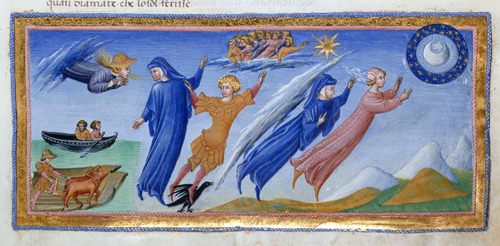
http://www.bl.uk/catalogues/illuminat...
Dante and Beatrice visiting the inhabitants of the heaven of the moon.
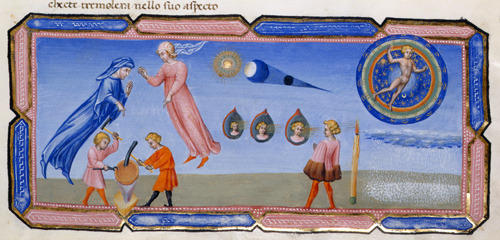
http://www.bl.uk/catalogues/illuminat...
Beatrice explaining some scientific theories to Dante, including the appearance of the moon.
More (view spoiler)
 Canto III illustrations
Canto III illustrations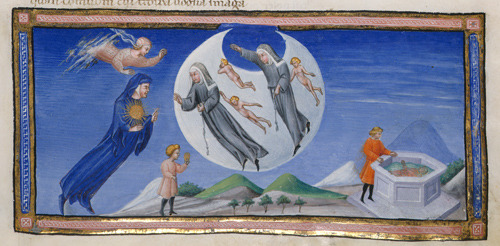
http://www.bl.uk/catalogues/illuminat...
Dante, with the sun of love on his chest, encountering nuns and naked men, including the spirits of Piccarda and Constance
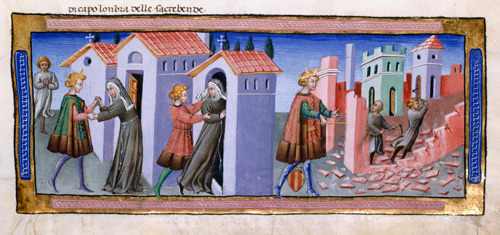
http://www.bl.uk/catalogues/illuminat...
Stories of Piccarda and Constance
More (view spoiler)
 Canto III music
Canto III musicAve Maria
Description: Marian antiphon. Sung by Piccarda in the Heaven of the Moon. In Paradiso 32 the angel Gabriel intones Ave Maria again.
Worldofdante's recording (there must be better ones on Youtube!):
http://www.worldofdante.org/pop_up_qu...
 Canto IV illustrations
Canto IV illustrations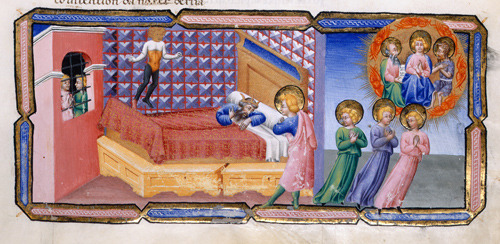
http://www.bl.uk/catalogues/illuminat...
Nebuchadnezzar, lying in bed, telling Daniel his dream, while Moses, John the Evangelist, and John the Baptist sit enclosed in a circle of seraphs, and the Archangels Raphael, Gabriel and Michael stand below

http://www.bl.uk/catalogues/illuminat...
Martyrdom of St. Lawrence
More (view spoiler)
 Canto V illustrations
Canto V illustrations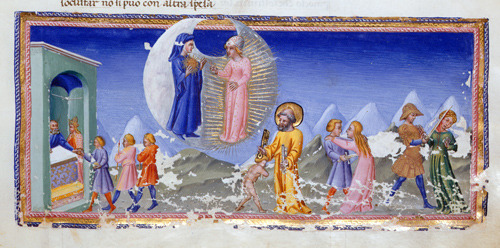
http://www.bl.uk/catalogues/illuminat...
Four further episodes in the Paradiso, including the sacrifice of Iphigenia.
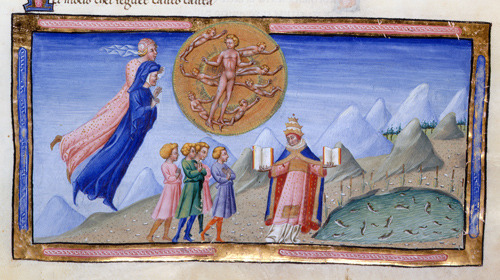
http://www.bl.uk/catalogues/illuminat...
Dante and Beatrice hovering before the Haven of Mercury, in which souls are enclosed, while below, four young men are standing before a Pope, who holds up open volumes containing the Old and New Testaments
More (view spoiler)
BP, I would love to have a collection of kites with the effigies from those illustrations...
LOL...
LOL...
Canto 5:
Compare: in fish pools that are still and clear, the fish are drawn- as though they guess at food- to anything that comes there from outside.
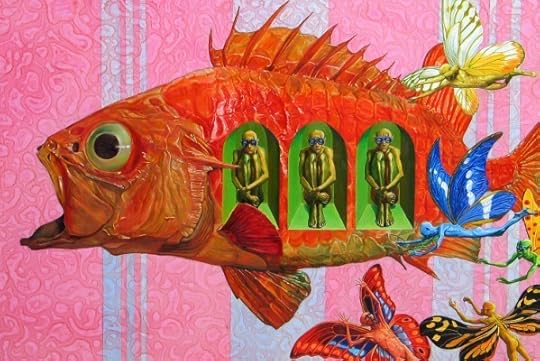 By Liu Zhi - born 1975
By Liu Zhi - born 1975
I read this and went on a search where I found our Lily: interesting discussion:
http://www.goodreads.com/topic/show/1...
Compare: in fish pools that are still and clear, the fish are drawn- as though they guess at food- to anything that comes there from outside.
 By Liu Zhi - born 1975
By Liu Zhi - born 1975 I read this and went on a search where I found our Lily: interesting discussion:
http://www.goodreads.com/topic/show/1...
 Kalliope wrote: "BP, I would love to have a collection of kites with the effigies from those illustrations...
Kalliope wrote: "BP, I would love to have a collection of kites with the effigies from those illustrations...LOL..."
These miniatures are beautiful, aren't they? They're from the Yates Thompson manuscript (full gallery here: http://www.bl.uk/catalogues/illuminat...) and for Paradiso there's two of them per canto! I'll try not to forget to put the other illustrations as well. ;)
 ReemK10 (Paper Pills) wrote: "Canto 5:
ReemK10 (Paper Pills) wrote: "Canto 5:Compare: in fish pools that are still and clear, the fish are drawn- as though they guess at food- to anything that comes there from outside..."
Nice illustration! Dante has some very effective images in these cantos, many of which refer to three of the elements (water, air, fire) as well as mirrors, pearls... I'm really enjoying that part (*whispers* more than the long theological discourses!).
I loved this image of a simple flame rising from canto I (139-141):
It would be cause for wonder in you if,
no longer hindered, you remained below,
as if, on earth, a living flame stood still.”
Maraviglia sarebbe in te se, privo
d'impedimento, giù ti fossi assiso,
com' a terra quïete in foco vivo."
 ReemK10 (Paper Pills) wrote: "I read this and went on a search where I found our Lily: interesting discussion:"
ReemK10 (Paper Pills) wrote: "I read this and went on a search where I found our Lily: interesting discussion:"Aha! Very interesting indeed. :) I'm half-way through the convo and they're having a good discussion... And I see our Lily posted some goodies last year (which I cannot help but paste here too!):

Amos Nattini, Paradiso Canto 5. "S'io ti fiammeggio nel caldo d'amore /"If in the heat of love I flame on you" 1923
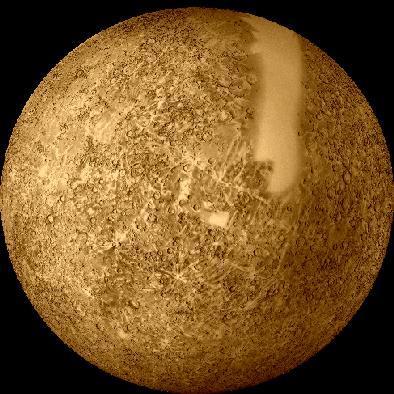
Mercury
Mercury, the closest planet to the Sun, remains the most mysterious of the Solar System's inner planets. Hiding in the Sun's glare it is a difficult target for Earth bound observers. The only spacecraft to explore Mercury close-up was Mariner 10 which executed 3 flybys of Mercury in 1974 and 1975, surveying approximately 45 percent of its surface. Mariner 10 deftly manuevered to photograph part of the sunlit hemisphere during each approach, passed behind the planet, and continued to image the sun-facing side as the spacecraft receded. Its highest resolution photographs recorded features approximately a mile across. A recent reprocessing of the Mariner 10 data has resulted in this dramatic mosaic. Like the Earth's Moon, Mercury's surface shows the scars of impact cratering - the smooth vertical band and patches visible above represent regions where no image information is available.
http://apod.nasa.gov/apod/ap980906.html
 Canto VI illustrations
Canto VI illustrations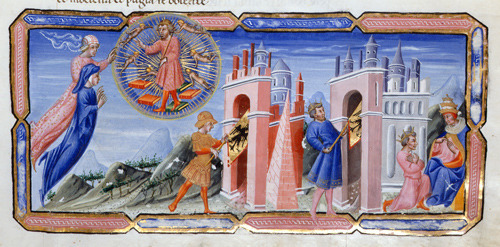
http://www.bl.uk/catalogues/illuminat...
Justinian
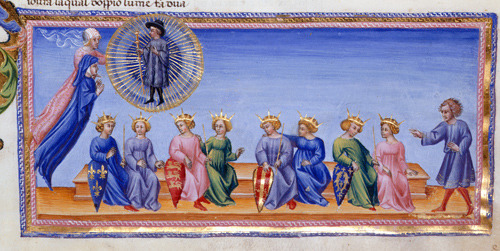
http://www.bl.uk/catalogues/illuminat...
Dante and Beatrice before the four daughters of Count Berengar
More (view spoiler)
 Canto VII illustrations
Canto VII illustrations
http://www.bl.uk/catalogues/illuminat...
Dante and Beatrice witnessing the mystery of the Redemption.
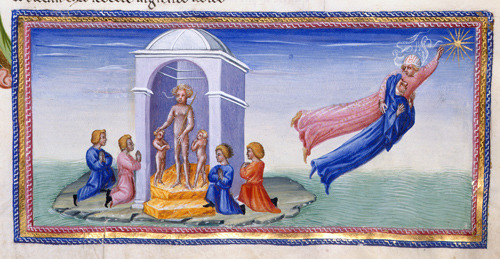
http://www.bl.uk/catalogues/illuminat...
Dante and Beatrice ascending the heaven of Venus
More (view spoiler)
 Canto VII music
Canto VII musicSanctus
Description: Ordinary chant. A hymn sung by Justinian which is Dante's invention, it recalls the Sanctus from the liturgy of the Mass, which is the hymn we have recorded here. This invented hymn mixes Latin with three Hebrew terms (Hosanna, sabaoth/hosts, malacoth/kingdoms).
http://www.worldofdante.org/pop_up_qu...
Read in canto 6, "The Eagle, too laid low the Arab boast." and per the bird theme:
This brought to mind the" Eagle: Bird which appeared on the Standard of the Roman Legions and symbolized the authority of the empire."...... and perhaps the Arabian phoenix.
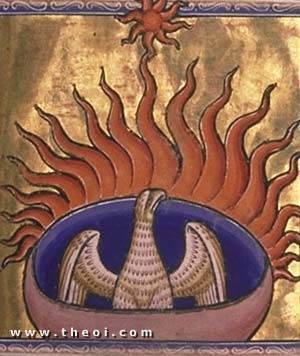
The Phoenix was a popular creature in Greek and Roman literature, and later occurs in Medieval bestiaries.
Arabian Phoenix
The story of death and rebirth of the phoenix originates in Arabian mythology. According to legend the phoenix lived in Arabia, but only one phoenix lived at any one time for 500 years. As the end of its life-cycle approaches, the phoenix builds a large nest of perfumed wood, lies down in the nest, impregnating it with its seed and then sets the nest on fire and is consumed by flames. After its death, a new Phoenix is reborn, arising from the ashes. This cycle is repeated for eternity. The Phoenix is symbolic of the death and rebirth of the sun. In another version of the legend, the newly born phoenix places the body of its mother in a hollow myrrh log, a perfumed wood, and carries it to Heliopolis in Egypt, where it burns on the Altar of the Sun. The young phoenix is followed by flocks of other birds during its flight to Egypt, and on its arrival, the priest of Heliopolis calls the people to witness the miracle about to take place. After the burning of its mother, the young phoenix returns to its home in Ethiopia, where it lives for 500 years on a diet of pearls and incense.
Allegory/Moral
The story of the phoenix is taken as an allegory of the death and resurrection of Christ, who had the power to lay down his life and to take it back again. The Aberdeen Bestiary adds that "The phoenix can also signify the resurrection of the righteous who, gathering the aromatic plants of virtue, prepare for the renewal of their former energy after death. ... Faith in the resurrection to come is no more of a miracle than the resurrection of the phoenix from its ashes. ... See how the nature of birds offers to ordinary people proof of the resurrection; that what the scripture proclaims, the working of nature confirms."
http://bestiary.ca/beasts/beast149.htm
This brought to mind the" Eagle: Bird which appeared on the Standard of the Roman Legions and symbolized the authority of the empire."...... and perhaps the Arabian phoenix.

The Phoenix was a popular creature in Greek and Roman literature, and later occurs in Medieval bestiaries.
Arabian Phoenix
The story of death and rebirth of the phoenix originates in Arabian mythology. According to legend the phoenix lived in Arabia, but only one phoenix lived at any one time for 500 years. As the end of its life-cycle approaches, the phoenix builds a large nest of perfumed wood, lies down in the nest, impregnating it with its seed and then sets the nest on fire and is consumed by flames. After its death, a new Phoenix is reborn, arising from the ashes. This cycle is repeated for eternity. The Phoenix is symbolic of the death and rebirth of the sun. In another version of the legend, the newly born phoenix places the body of its mother in a hollow myrrh log, a perfumed wood, and carries it to Heliopolis in Egypt, where it burns on the Altar of the Sun. The young phoenix is followed by flocks of other birds during its flight to Egypt, and on its arrival, the priest of Heliopolis calls the people to witness the miracle about to take place. After the burning of its mother, the young phoenix returns to its home in Ethiopia, where it lives for 500 years on a diet of pearls and incense.
Allegory/Moral
The story of the phoenix is taken as an allegory of the death and resurrection of Christ, who had the power to lay down his life and to take it back again. The Aberdeen Bestiary adds that "The phoenix can also signify the resurrection of the righteous who, gathering the aromatic plants of virtue, prepare for the renewal of their former energy after death. ... Faith in the resurrection to come is no more of a miracle than the resurrection of the phoenix from its ashes. ... See how the nature of birds offers to ordinary people proof of the resurrection; that what the scripture proclaims, the working of nature confirms."
http://bestiary.ca/beasts/beast149.htm
 janet wrote: "I am still getting into the reading of Paradiso, and didn't finish canto 7 until late on Sunday night. I was, I guess, comforted or something like it to see Dante managing to incorporate some polit..."
janet wrote: "I am still getting into the reading of Paradiso, and didn't finish canto 7 until late on Sunday night. I was, I guess, comforted or something like it to see Dante managing to incorporate some polit..."I took me longer to read these opening cantos too. They felt much denser than in the previous two volumes. They are more lyrical and tackle what felt a bit like a crash course in Christian theology! I'm heavily relying on the annotations to get most of the aspects covered by Dante.
Thank you for the music links! :)
Books mentioned in this topic
The Complete Danteworlds: A Reader's Guide to the Divine Comedy (other topics)The Complete Danteworlds: A Reader's Guide to the Divine Comedy (other topics)
The Complete Danteworlds: A Reader's Guide to the Divine Comedy (other topics)
The Complete Danteworlds: A Reader's Guide to the Divine Comedy (other topics)




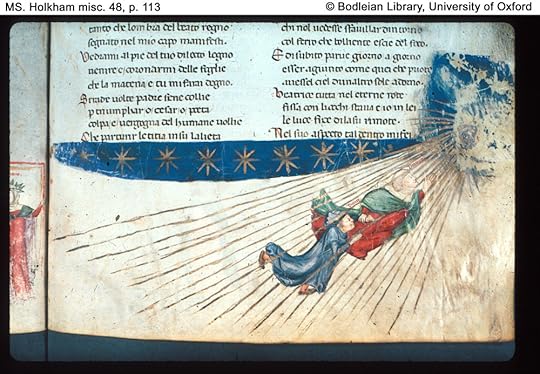
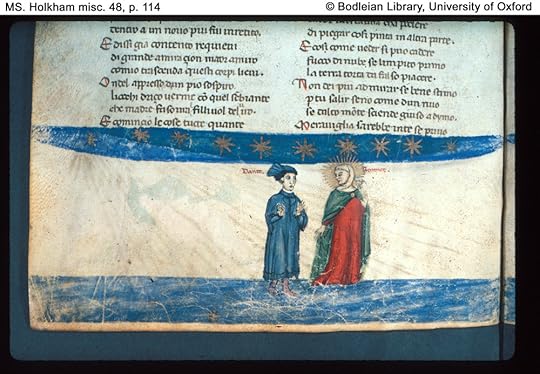
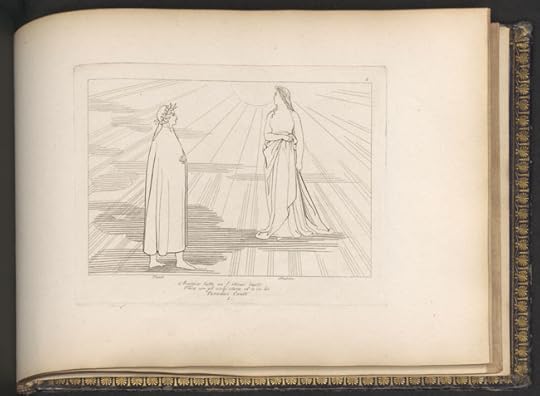
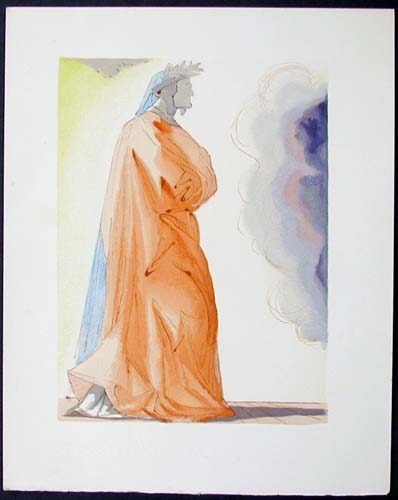
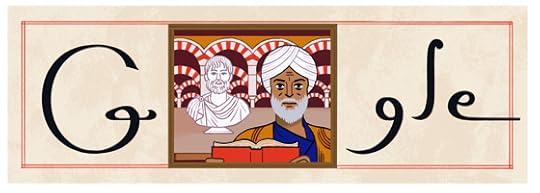
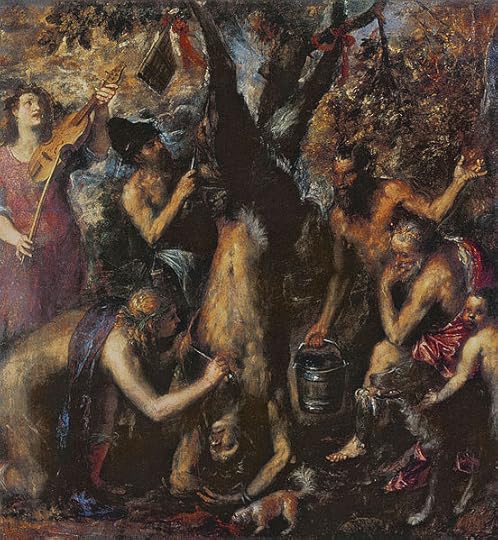
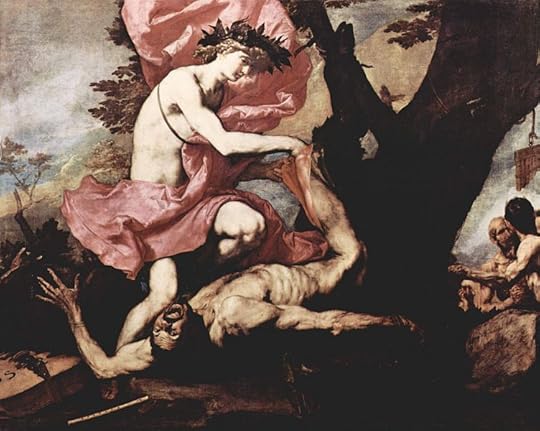


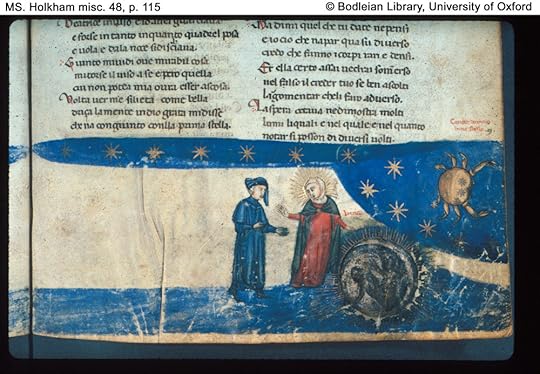
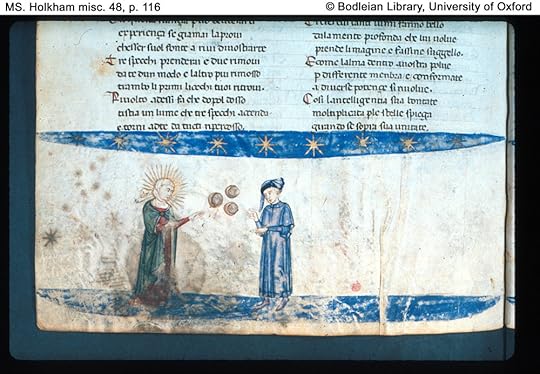

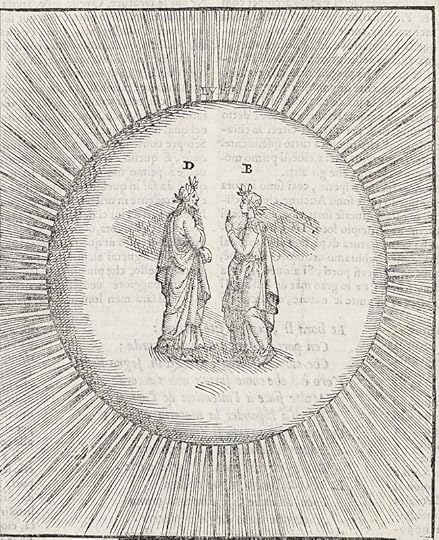

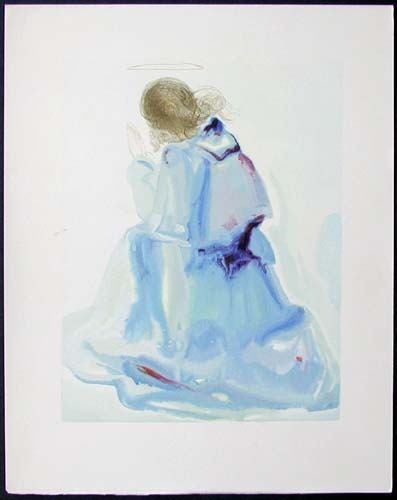
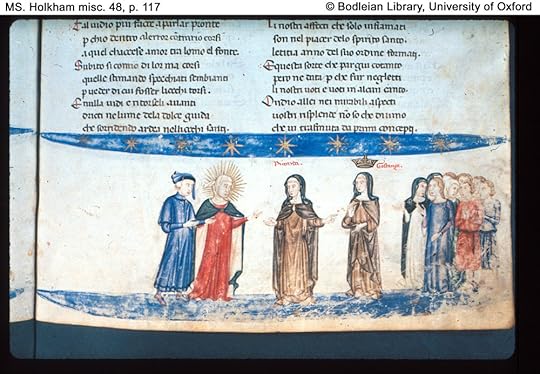
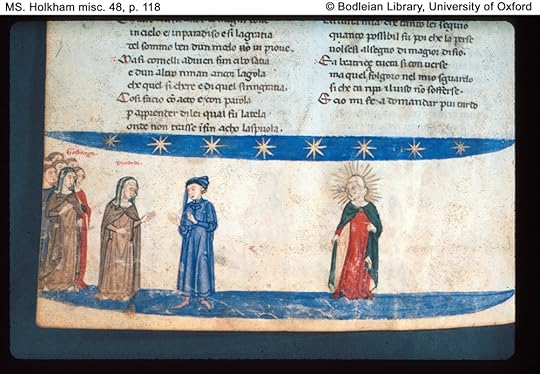
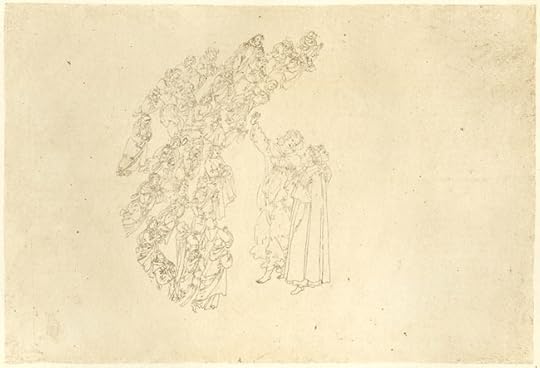
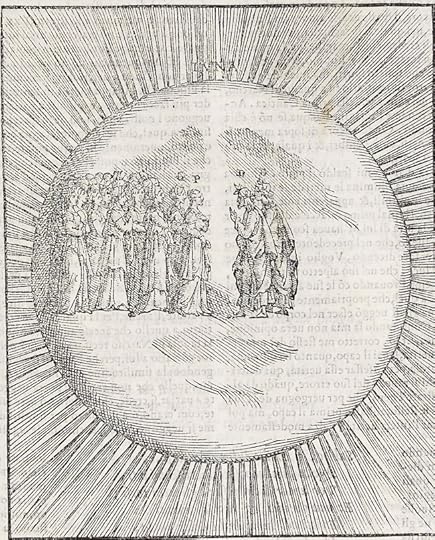


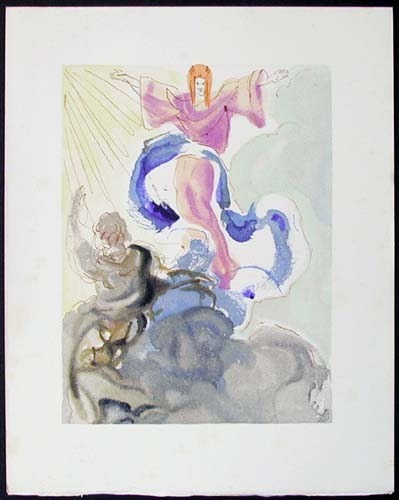
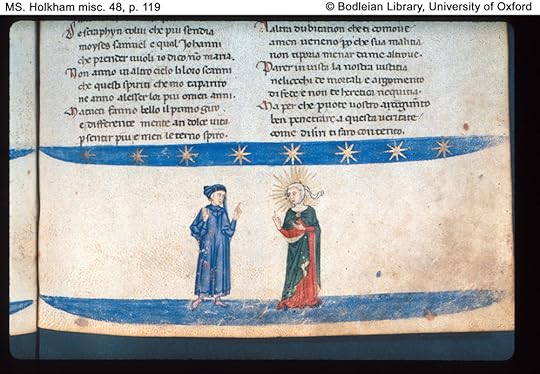
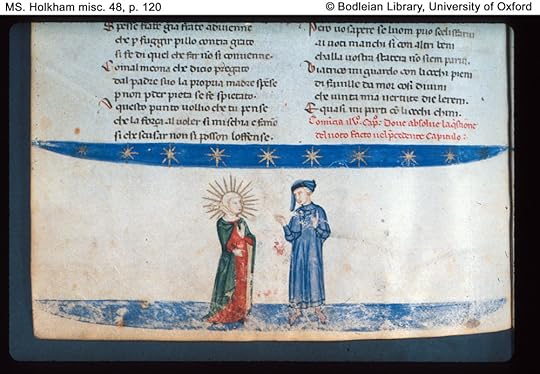
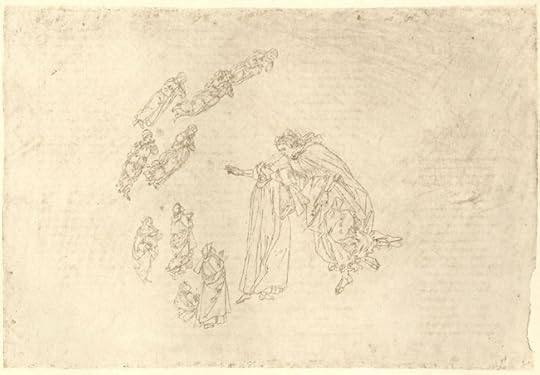
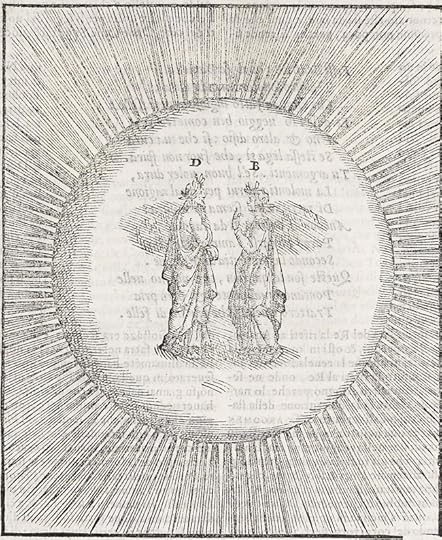
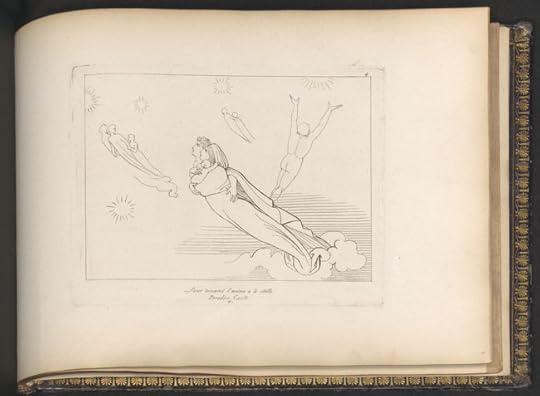
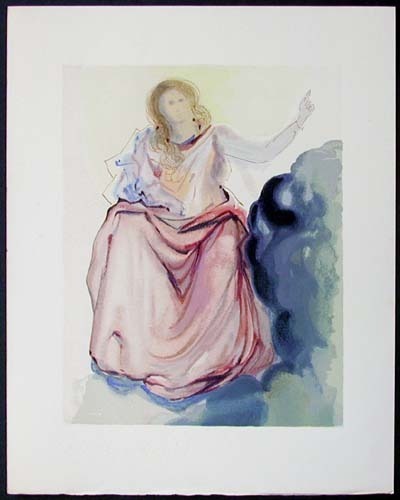
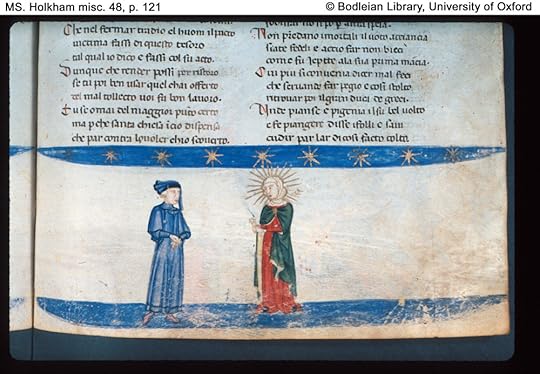
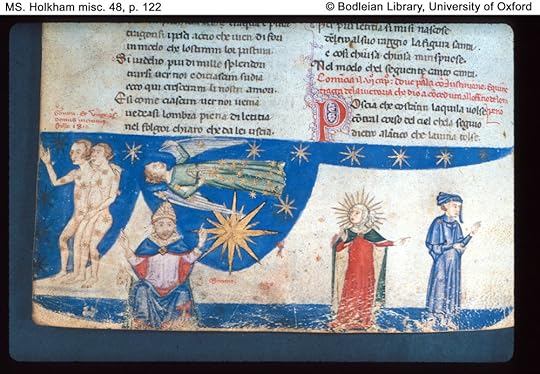

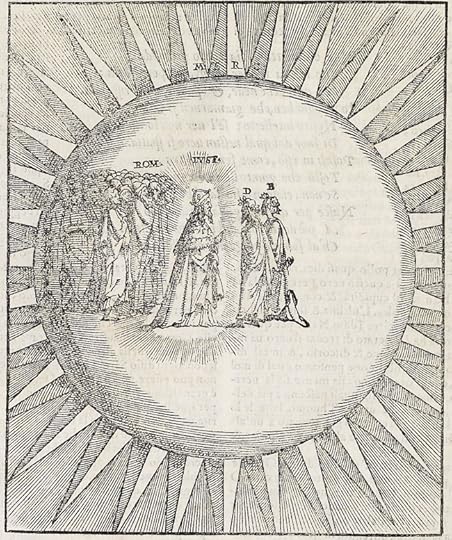

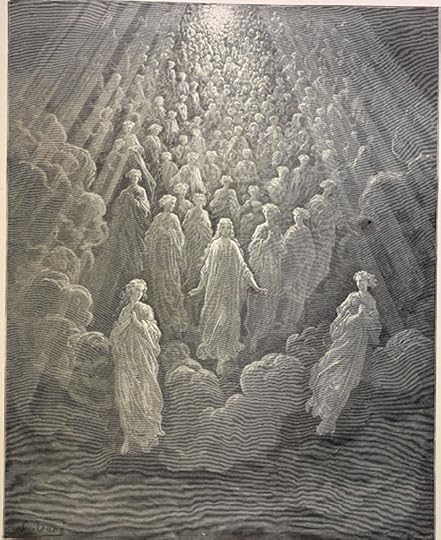
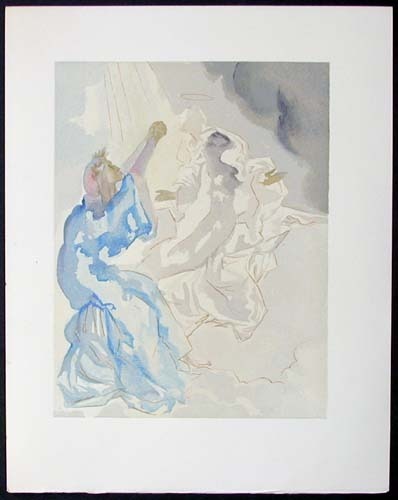
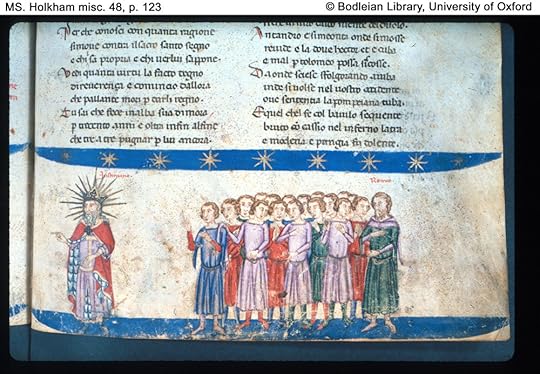
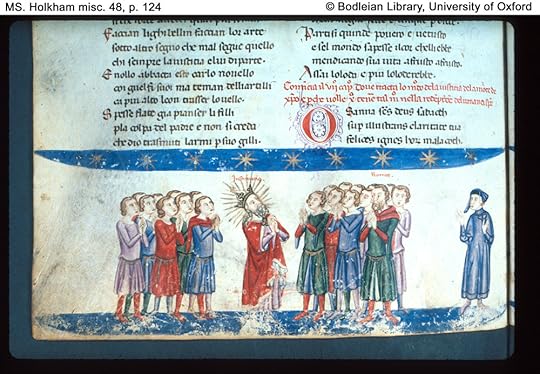
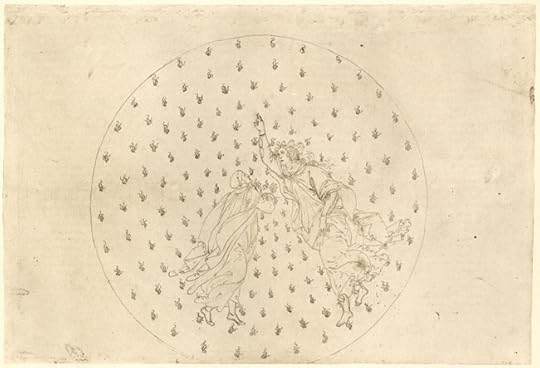
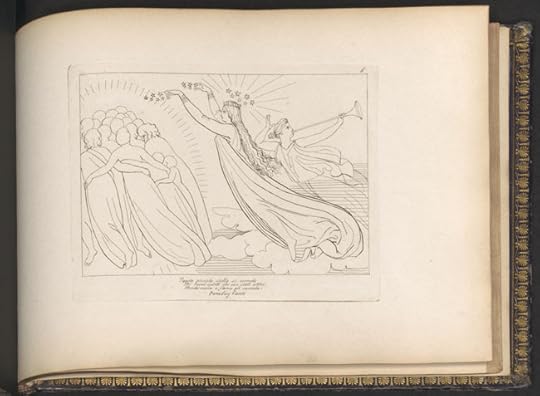
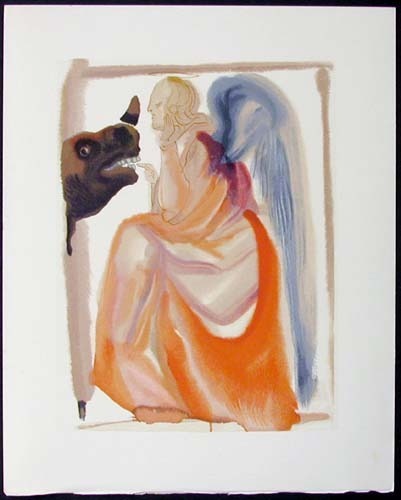

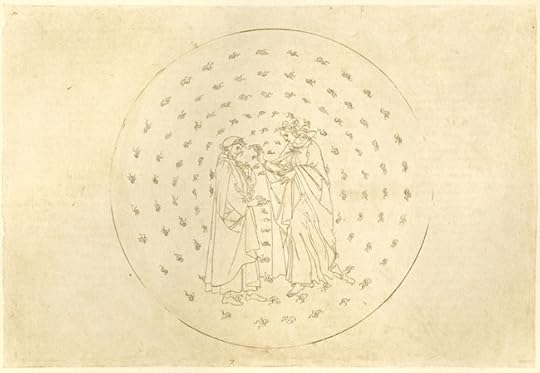
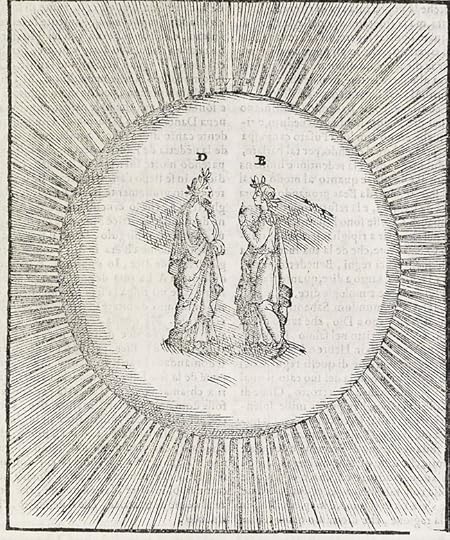
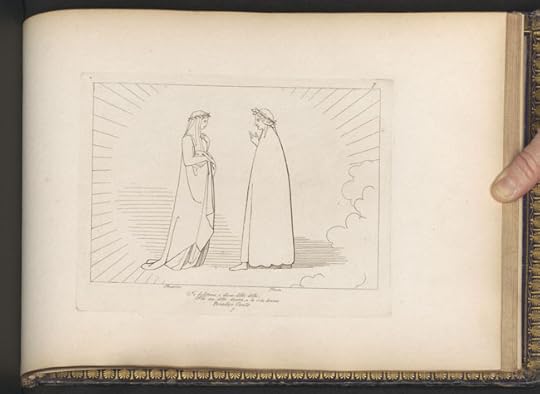
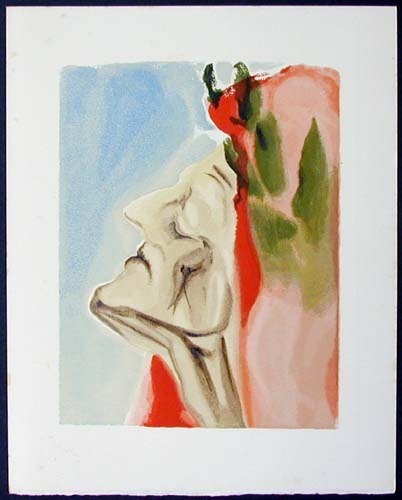


Torta Paradiso
From TheSpicedLife
Closely adapted from Grace Massa Langlois
Ingredients
6 large egg yolks
4 large egg whites
150 g (3/4 g + 3 T) potato starch (can sub cornstarch)
150 g (1 cup + 3 T) AP flour
½ package (8 g) “lievito vaniglinato” (“yeast for cake,” i.e., single acting baking powder)
¼ t fine sea salt
300 g (1⅓ cups) unsalted butter, room temperature, plus more for greasing pan
300 g (2¼ cups + 2½ T) confectioners’ sugar, divided, plus more for dusting
1 t vanilla paste (can sub 2 t vanilla extract)
2 t vanilla extract
zest of 1 lemon
Instructions
Place the egg yolks in one bowl and the egg whites in another, cover each with plastic wrap and leave while you prepare other steps so that the eggs warm to room temperature.
Preheat the oven to 350 F.
Using a 9 or 10 inch pan with 3-inch high sides (I used a springform), line the bottom and sides with parchment paper. Then lightly butter that parchment paper (if you have trouble with the parchment staying in place, lightly grease the pan under the parchment paper). This is a delicate cake, so for the prettiest cake I recommend you do this. Set aside.
Sift the potato starch and flour into a medium sized bowl. Whisk in the “cake yeast” (single acting baking powder) along with the salt–make sure it is all combined thoroughly. Set aside.
Now switch to a stand mixer fitted with the paddle attachment. Beat the butter until creamy, then add half of the confectioners’ sugar, the vanilla paste and extract and lemon zest. Beat until creamy and pale, about 6 minutes, on medium speed. Scrape down the sides and bottom of the bowl twice in the middle of this.
Add the egg yolks one at a time, continuing to beat on medium speed, again scraping down the sides and bottom of the bowl at least twice. This process–adding the yolks–should take about 3 minutes.
Now switch to a medium-large bowl with a hand mixer (or if you are lucky enough to own 2 stand mixer bowls, switch to a clean bowl and the whip attachment). I had some trouble with this next step but the cake still came out perfectly, so do not get too stressed out by it. Whip the egg whites until they hold barely soft peaks. Reduce the speed to medium low, and very slowly (I think I added the sugar too fast) add the remaining confectioners’ sugar by the tablespoons, mixing to incorporate before adding the next tablespoon. When you have incorporated all of the sugar, increase the speed to high and ideally whip the egg whites until stiff. Mine did not whip stiff and instead acted more like royal icing, so if this happens to you do not stress, just stop there. (If the egg whites do not beat into soft peaks at all however, there is probably a problem in your bowl or whip attachment, such as fat in the bowl, and you will need to start over.)
Returning to the egg yolk mixture, add the flour mixture with the paddle speed on low, and mix the flour in. The batter will be quite stiff. Scrape the sides and bottom of the bowl. Add about ¼ of the egg white mixture and quickly but gently mix it in using a spatula.
This will lighten the batter. Add the remaining egg whites and gently fold them in. When they are completely incorporated, scrape the batter into the prepared pan and smooth the top.
Bake until golden brown and a cake tester inserted into the center of the cake comes out clean, about 45-55 minutes. If your oven cooks unevenly, rotate the pan halfway through.
Transfer the cake to a cooling rack and let it cool for 25 minutes.
Removing the cake was even easier with a springform pan–I released the sides, carefully peeling away the parchment, and then used my cake lifter to quickly move the cake to a cooling rack. If you used a regular cake pan, place parchment paper over the pan, quickly invert the cake onto the parchment, and then invert it back onto a cooling rack.
Let the cake cool completely.
Unlike a denser or richer cake, powdered sugar on this cake will not absorb into the cake and get gummy. So when the cake is cool, sift confectioners’ sugar all over the top of the cake. Transfer to a cake stand or plate.